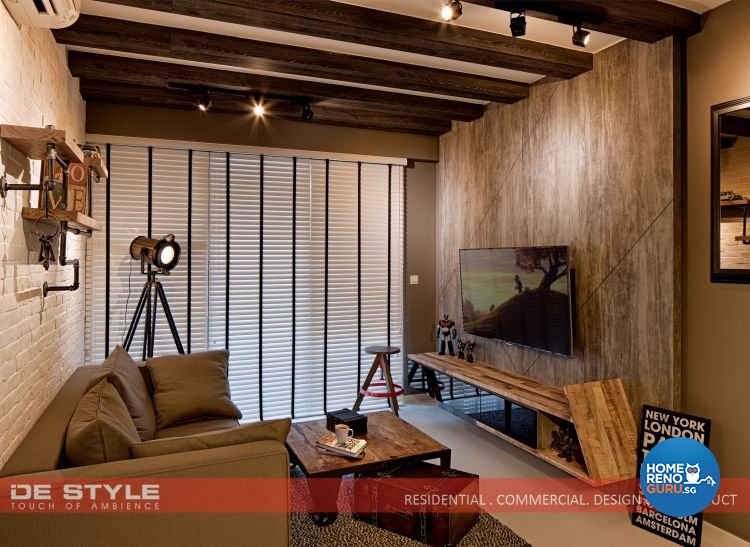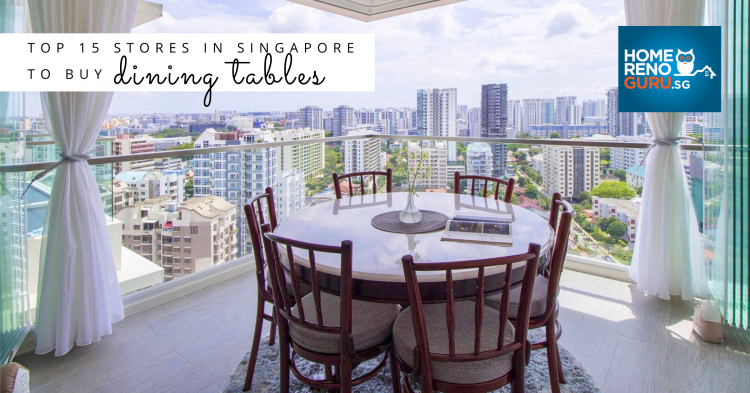Many ID firms’ portfolios look remarkably ‘samey’. Design themes tend to fall into predictable categories, with ‘minimalist’, ‘industrial chic’ and ‘rustic’ constantly topping the list. How much of it is the inevitable result of the uniformity of HDB flat layouts? And how much of it is just lazy, unimaginative design? Perhaps more importantly, who is to blame – designers, homeowners or both? We asked industry leaders.
NO ARGUMENT

If you think that Singapore’s interior design industry has fallen into the rut of copycat design, you are not alone. When we asked the senior designers and principals of some of Singapore’s leading players, we were somewhat surprised to find that nobody emphatically disagreed with the claim.
“The industry thrives on a certain level of consistency. There are few risk takers among designers and customers,” said Astley Ng, Regional Design Principal of Sky Creation Asia, whose sentiments pretty much echoed those of all the designers we interviewed.
“The majority of clients in the local context are generally more conservative. Most of them would rather go for the safer approach of picking and choosing ideas from magazines and existing portfolios,” said Erin Tan, General Manager of Vegas Interior Design.
“It’s somewhat true that design themes have become predictable due to some common reasons,” said Philip Peh, Project Director of Project i, hinting at a conspiracy of factors that explains the scarcity of creativity in the local industry.
While nobody denied the prevalence of ‘déjà vu design’, all were quick to offer their theories as to the reasons behind it.
HDB FLATS FLATTEN THE PLAYING FIELD

Obviously, the limitations of uniform HDB flat layouts impose certain restrictions on both homeowners’ and designers’ creativity. Among them are space constraints and relatively low ceiling heights. Add to that the strict regulations prohibiting structural changes and the concealment of conduits, trunking and pipes, and you already have little room to move, say some.
“Aside from the obvious shortcoming of size, one of the bigger challenges that designers face is the ‘one size fits all’ characteristic of HDB flats, which by default, are mass housing solutions,” commented Norman Yeo, the Creative Director of OSC (formerly One Stop Concept).
Astley Ng, Regional Design Principal of Sky Creation Asia, highlighted the fact that hasty and misguided but well-intended attempts to break out of the mould have led to regrettable mistakes.
“It falls onto the architect to make sure that the internal layout is able to accommodate the placement of essential cabinetry. Some of the disastrous layouts I have seen have focused on making the home’s facades look eye-catching and dynamic. This offers little comfort to the occupants. Mistakes like designing long and narrow bedrooms, angular or triangular layouts and even round walls make optimal space planning very difficult,” explained Astley Ng.
In other words, it makes life easier for designers and clients alike not to walk on the wild side of interior design. When you stick to the straight and narrow, or rather ‘the linear and laminate’, there are no risks, but no surprises either.
The challenge for designers is to modify this ‘one size fits all’ solution to fit the unique needs of the individual homeowner. No small order, especially when the budget is anything but big.
DOLLARS AND CENTS

The limitations of HDB flat layouts aside, the Singaporean obsession with cost-efficiency – a blend of kiasu-ism and a very forgivable response to the rising cost of living – is a real and sometimes insurmountable barrier to creativity within the interior design industry.
Phillip Peh, Project Director of Project i, cites the ‘price war’ as a key factor in limiting designers’ and homeowners’ creativity. “The price war and the subsequent decreasing profits from HDB flat renovations have resulted in a decreasing emphasis on creativity among designers and clients alike,” he explained.
Norman Yeo of OSC concurred: “It is almost the norm in Singapore to want the most for the least, and in the quickest time possible.”
Other designers cited the resale value of the flat as another factor that makes homeowners think twice before taking a leap of faith and imagination and daring to be different with their interior design. Hence, many clients opt for a modern, minimalist, dare we say ‘bland’ look that neither offends nor excites.
Clearly, time and money are two major hurdles for designers to clear before they are able to conceptualise and implement truly creative design. And they are no small hurdles. After all, it is generally true to say that time and money are two things that stressed-out and cash-strapped Singaporeans are reluctant to part with.
CLOSED MINDS CLOSE DOORS

Yet another factor cited by the majority of designers interviewed was the aversion to risk-taking that prevails among the local population. It seems that we are a timid lot when it comes to thinking out of the box and ‘colouring outside of the lines’.
This conservative mindset no doubt owes something to the Confucian values of our forebears, which prizes collectivism above individualism, respects tradition and advocates moderation.
Wilson Teh, Executive Director of Rezt & Relax Interior, explained: “The problem lies in what homeowners generally demand. Not every homeowner has a creative mind and many want to play it safe. Some will inevitably go for the tried-and-tested formula. While one would argue that it is the job of the designer to inject his or her own creative input, some homeowners are not receptive at all. In the end, the homeowner calls the shots.”
Astley Ng of Sky Creation Asia summed it up: “Familiarity is usually the first challenge to creativity.”
As humans first and Singaporeans second, we are irresistibly drawn to the ‘known’ and shy away from the unknown. Call it the herd instinct, or simply a desire not to be mocked for our unconventional choices.
Norman Yeo of OSC had his own insightful views on the Singaporean mindset. “Singapore in general is a product of its own circumstances – it is probably what it is today because of its efficiency in governance, its reliance on systems, its obsession with cost-efficiency and its no-nonsense intolerance of divergent and independent ideas. The result is a society with a cookie-cutter mindset that is obsessed with productivity – a self-imposed constraint on time and money.”
And so it seems that we Singaporeans are both beneficiaries and victims of our nation’s success. In other words, our famous pragmatism is a double-edged sword.
There must be something that can be done to overcome these barriers – the limitations of HDB flat layouts, the cost-driven competitiveness of the market, and the risk-averse mindset of Singaporean homeowners.
What to do? Plenty, according to the optimistic and enterprising industry authorities we spoke to.
WE SHALL OVERCOME

The general tone when it came to discussing the future of the interior design industry was upbeat. There was no shortage of suggestions as to what can be done to overcome the barriers to creativity that are currently in place.
Here is a summary of the pro-active steps to encourage creativity in interior design, suggested by local industry leaders.
To save misunderstandings, it is important to establish the homeowner’s wish-list from the onset of every project, so that the designer has a set of clear guidelines to work within. True creativity is, after all, working within constraints.
“Homeowners should immediately let the designer know of their specific requirements and their limitations. This will lead to a more harmonious working relationship.”
– Wilson Teh, Executive Director, Rezt & Relax
Spend time with your clients and get to know their personal passions and pastimes. Find out what is truly valuable to them, and design around it. They will then be more inclined to accept your boldest proposals, confident in the knowledge that you ‘get’ them.
“When we know the lifestyles and stories of the homeowners, we are able to create designs that are innovative yet highly personal and relevant to their daily lives. That will increase their appetite for risk-taking.”
– Gisella Seah, Marketing Manager, Darwin Interior
Look away from designer brands and towards everyday things, endowed with sentimental value. Interior design planned around a cherished keepsake is the very opposite of copycat design.
“Seek inspiration from everyday objects and artefacts – especially old ones. Garden bench from a childhood home or kampong? Old Vespa bike from one’s heyday? Treasured painting from one’s schooldays? Breathe life into old objects, build upon old memories and create new opportunities to forge new memories. The home, after all, is a container of love and memories.”
– Norman Yeo, Creative Director, OSC (formerly One Stop Concept)
OSC (formerly One Stop Concept)
Rather than pushing every client into signing up for a package with an all-in cost and no surprises, designers should open their clients’ eyes to what can be done with a little more money. Choices are a client’s right, and only the most cynical among them will resent being ‘upsold’.
“There should be a higher pricing in place for complicated and unique designs, or a separate design fee that is chargeable.”
– Philip Peh, Project Director, Project i
Since good design demands that form follows function, do not get seduced by trends that are mindlessly grafted onto spaces with little regard for the practical needs of the occupants. A snazzy, jazzy space that is quickly outdated and uncomfortable to live in is not creativity – it is laziness and bad design.
“Too often we centre our work around the aesthetic and this creates a lot of duplicity and lack of creativity.”
– Astley Ng, Regional Design Principal, Sky Creation Asia
Designers should look not so much within, but beyond Singapore. Only then can we grasp global trends and adapt them to the local market from an informed point of view.
“Travel more, experience more. Bring back your experiences to Singapore and adapt them. Make them better. Make them relevant to Singapore and Singaporeans.”
– Norman Yeo, Creative Director, OSC (formerly One Stop Concept)
OSC (formerly One Stop Concept)
Offer your clients more inspiration – more reference shots, more material samples, more food for thought. Gently challenge them to step outside of their comfort zone – without making them feel uncomfortable.
“Source better image references of unique and daring designs. Prepare plenty of material samples for your presentations and proposals. Let owners feel and touch the materials that link to the end result.”
– Alan Chan, Design Consultant, Edgeline Planners
Gain experience. Resist the urge to hop from firm to firm for an ‘instant promotion’. A convincing voice of authority inspires confidence in clients, who will then be more inclined to buy into your visions.
“For designers, imagination and creativity also come with experience. A more experienced interior designer may be able to visualise concepts more effectively and come up with more extraordinary designs that differ from the usual trends.”
– Dowin Ho, Director, De Style Interior Pte Ltd
We’re in it together. Lifting industry standards will benefit the industry as a whole in the long term. Besides, being secretive is not an option in this digital age of Internet access. More can definitely be done in terms of educating – or rather enlightening the public on the pitfalls of copycat design and the viable options available.
“Interior designers can explore the possibilities of organising workshops to share design views and knowledge with the general public. This could enhance the credibility of the entire industry, and allow designers to develop their creativity with more freedom and imagination.”
– Erin Tan, General Manager, Vegas Interior Design
BRING ON THE FUTURE
All in all, while the present situation may appear somewhat dull, the future looks very bright indeed for the future of interior design in Singapore.























